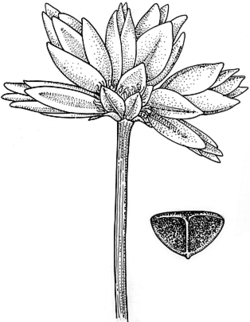
Description: Tufted rhizomatous perennial herbs, roots stilt-like and fibrous.
Leaves cauline, ± terete to triquetrous, numerous and sessile in tufts, scattered along stems leaving leafless intervals; bases sheathing, the margins scarious to finely divided.
Inflorescence terminal, scapose, head-like umbel with involucre of imbricate scarious bracts; outer bracts entire; floral bracts with jagged to finely divided margins; flowers pedicellate. Tepals 1-veined, not twisting after flowering, persistent, white to pink to greenish; outer tepals free; inner tepals shortly united or free. Stamens 6, slightly shorter than inner tepals, inner 3 fused to inner tepals; filaments terete; anthers dorsifixed, introrse, dehiscing by longitudinal slits. Ovules 1–8 per loculus; style filiform; stigma dilated, entire.
Fruit a capsule, enclosed in persistent perianth; seeds 3–12, triangular, nippled, dull black.
Distribution and occurrence: World: 13 species, endemic Australia. Australia: all States.
Laxmannia is sometimes placed in the segregate family Laxmanniaceae.
Text by S. McCune & D.W. Hardin
Taxon concept:
| | Key to the species | |
| 1 | Inflorescences exceeding leaves; scapes erect, more than 8 mm long | 2 |
| Inflorescences not exceeding leaves, on short decurved scapes more or less 5 mm long | Laxmannia orientalis |
| 2 | Plants compact and prostrate; outer tepals usually equal to or longer than inner tepals | Laxmannia compacta |
| Plants erect; outer tepals usually shorter than inner tepals
Back to 1 | Laxmannia gracilis |
|


